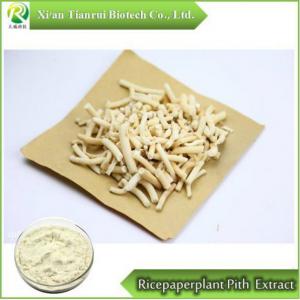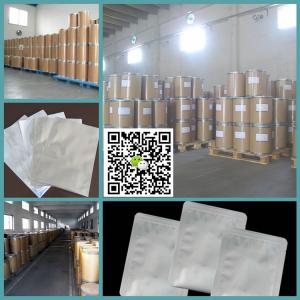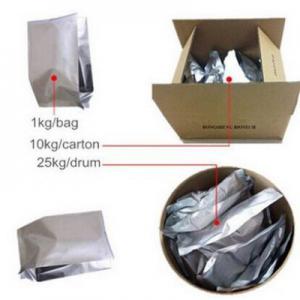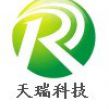Factory Natural Rice-Paper plant 10:1 Extract Powder
Product Name: Rice-paper Plant Extract
Ratio Extract: 4:1,10:1,20:1
Test Method: TLC
Appearance: Brown powder
Mesh:100% pass 80 Mesh
Pharmaceutical & Food Grade
About Rice Paper Plant
Rice paper plant, also known as Tetrapanax papyriferum or Tong Cao in mandarin, is a traditionally used medicinal plant. And the main medicinal part is its long, round pith, which looks like a wick and touches like sponge or foam. Rice paper plant pith, a medium-grade drug initially included and rated by the "Shen Nong's Herbal Classic", has a long history of use in folk medicine as a galactagogue. But don't confuse it with clematis vine or Aristolochia manshuriensis when used as Chinese herbal medicine because these two herbs were also called "Tong Cao" in the ancient medical books. As a matter of fact, they are three totally different herbs medicinally.
What is a rice paper plant?
Medicinally it primarily refers to the dry pith of Tetrapanax papyriferum (Hook.) Koch, which is the only species in the genus Tetrapanax of the family Araliaceae. Sometimes papyriferum can be spelled as "papyrifera", "papyriferus", or "papyrifer" too. That's to say, these 4 versions are all accepted well. Besides, it has a variety of common names, such as Medulla Tetrapanacis, Ricepaperplant Pith, Ricepaper Pith, Tong Tuo Mu, Tetrapanax papyrifer, Tetrapanax papyrifera, Tetrapanax papyriferus, and the like. It is mostly cultivated in Guizhou, Yunnan, Sichuan, Taiwan, and Guangxi. The medicinal stems are reaped in autumn. And then cut them into sections, take the fresh pith out when they are still fresh, straighten, dry in the sun, and slice. Medicinally it is used raw.
Tetrapanax papyriferum is a shrub, up to 6 meters in height. Stems are woody but soft, flake-like when young but gradually full when older, and with white pith in the middle. The young branches are densely covered with stellate hairs, or slightly with grayish yellow deciduous fluff. Large leaves, usually clustering in the upper stem, are palmately divided, up to 1 meter long, and with heart-shaped base, 5-7 lobed blade, stout, 30 to 50cm petiole, and 2 stipules. Flowers are small and petiolate. Most globular umbels arrange into a large cone. Drupelike berry is nearly spherical and flat. Exocarp is fleshy, hard and brittle. Bloom time is in August and fruiting time is in September. By the way, rice paper plant flowers, buds, root, and pollen are used for medicinal purposes too.
Its pith contains 5.95% ash, 1.07% fat, 1.11% protein, 48.73% crude fiber, 5% pentosan and 28.04% uronic acids. By hydrolyzing the sodium hydroxide extract of its polysaccharide obtains α-galactose, glucose, and xylose; the ammonium oxalate extract obtains galacturonic acid. In addition, it still contains aspartic acid, threonine, leucine, phenylalanine and other 13 kinds of amino acids and calcium, barium, magnesium, iron and other 18 kinds of trace elements. Its xylem contains lignin. Its leaves contains papyrioside L-II a, L-II b, L-II c, L-II d, paryriogenin A-J, propapyriogenin A1, A2, and quercitrin.
Rice paper plant health benefits
As mentioned in the beginning, it is an herb that is often used to increase milk supply. However, the reason it is named so is because it is the raw material of rice paper or pith pater, which is not only used for watercolor drawings in white sheets, but also widely dyed in many colors for making man-made flowers. But it is very seldom to be used for writing because of its texture. Besides, rice paper art and rice paper lamp are the relevant popular items too.
Modern pharmacology has confirmed that it is diuretic and can significantly increase the urinary excretion of potassium and promote milk secretion and so on. What's more its polysaccharide is with a certain antioxidant and immunity-regulating effects. In summary, its top 7 health benefits are as follows:
1) Ventilating Qi and promoting lactation. A blocked duct during breastfeeding or less breast milk production can be caused by a variety of elements, such as pathogenic cold, heat, spleen-stomach deficiency, liver qi stagnation, and so on. Its pith is suited for clogged milk duct regardless of any reasons since it is good at clearing out clog and acting on stomach meridian. As a result it can lead Qi upwards and thereby let breast milk flow through milk ducts out the nipple;
2) Promoting blood circulation. It can be used in the treatment of the Jue-syndrome, whose main clinical presentation includes cold limbs, feeble pulse, cold abdominal pain, hernia pain, or delayed menstrual cycle in women. It is of dredging nature and adept in bridging Yin and Yang, connecting nine orifices insides, and getting through nutrient-blood. Zhang Zhongjing, a famous physician in the Eastern Han Dynasty, used it to treat Jue-syndrome of cold nature;
3) Clearing damp and promoting diuresis. Since it is of sweet, thin in flavor and of slightly cold nature, clinically it can be used for scanty dark urine or stranguria due to heat and dampness binding in the bladder;
4) Treating nasal congestion. When you can't smell anything because of the clogged nose, it is a good idea to relieve it by combining it with Xi Xin (Herba Asari) and Fu Zi (aconite), grinding them into powder, mixing them with honey, wrapping them with a cloth, and sticking it up your nose;
5) Increase the flow of urine. Its decoction has significant diuretic effect, which can significantly increase the discharge of potassium ion, but can't influence the discharge of sodium and chloride ion;
6) Lowering blood lipid. It can promote the liver fat metabolism and reduce blood lipid;
7) Promoting calcium absorption. It can help promote the absorption of calcium in human body.
Packing/Shelf life/Shipping/Payment terms
......................................................................................................................
Shipping & Delivery
Transit could be DHL,UPS,TNT,EMS,Fedex,and so on.
For mass orders, it will be delivered by air or sea.
Depending on your location, please allow 1-5 business days for your order to arrive.
For small order, please expect 3-7 days by UPS DHL EMS.
For mass order, please allow 5-8 days by Air, 15-30 days by Sea.
We have our own planting base in Gansu & Ningxia, covering an area of more than 10000 acres, being convenient for production.
......................................................................................................................
About Us
Xian Tianrui Bio - Tech Co.,Ltd is a professional manufacturer devoted to manufacturing all kinds of natural herbal extract.Most of our raw materials come from Chinese medical plant. At present we have plant bases of ourselves in Ningxia.Such as we have bases of Astragalus membranaceus and Radix isatidis, Burdock root, Codonopsis pilosula, Radix bupleuri, Sea buckthorn, so that sufficient raw materials of high quality can be supplied. The cost of our products be reduced at the same time we can supply products with more stable quality and more competitive prices.
Our products: Plant extract,Fruit powder,Enzyme powder
Product Name: Rice-paper Plant Extract
Ratio Extract: 4:1,10:1,20:1
Test Method: TLC
Appearance: Brown powder
Mesh:100% pass 80 Mesh
Pharmaceutical & Food Grade
About Rice Paper Plant
Rice paper plant, also known as Tetrapanax papyriferum or Tong Cao in mandarin, is a traditionally used medicinal plant. And the main medicinal part is its long, round pith, which looks like a wick and touches like sponge or foam. Rice paper plant pith, a medium-grade drug initially included and rated by the "Shen Nong's Herbal Classic", has a long history of use in folk medicine as a galactagogue. But don't confuse it with clematis vine or Aristolochia manshuriensis when used as Chinese herbal medicine because these two herbs were also called "Tong Cao" in the ancient medical books. As a matter of fact, they are three totally different herbs medicinally.
What is a rice paper plant?
Medicinally it primarily refers to the dry pith of Tetrapanax papyriferum (Hook.) Koch, which is the only species in the genus Tetrapanax of the family Araliaceae. Sometimes papyriferum can be spelled as "papyrifera", "papyriferus", or "papyrifer" too. That's to say, these 4 versions are all accepted well. Besides, it has a variety of common names, such as Medulla Tetrapanacis, Ricepaperplant Pith, Ricepaper Pith, Tong Tuo Mu, Tetrapanax papyrifer, Tetrapanax papyrifera, Tetrapanax papyriferus, and the like. It is mostly cultivated in Guizhou, Yunnan, Sichuan, Taiwan, and Guangxi. The medicinal stems are reaped in autumn. And then cut them into sections, take the fresh pith out when they are still fresh, straighten, dry in the sun, and slice. Medicinally it is used raw.
Tetrapanax papyriferum is a shrub, up to 6 meters in height. Stems are woody but soft, flake-like when young but gradually full when older, and with white pith in the middle. The young branches are densely covered with stellate hairs, or slightly with grayish yellow deciduous fluff. Large leaves, usually clustering in the upper stem, are palmately divided, up to 1 meter long, and with heart-shaped base, 5-7 lobed blade, stout, 30 to 50cm petiole, and 2 stipules. Flowers are small and petiolate. Most globular umbels arrange into a large cone. Drupelike berry is nearly spherical and flat. Exocarp is fleshy, hard and brittle. Bloom time is in August and fruiting time is in September. By the way, rice paper plant flowers, buds, root, and pollen are used for medicinal purposes too.
Its pith contains 5.95% ash, 1.07% fat, 1.11% protein, 48.73% crude fiber, 5% pentosan and 28.04% uronic acids. By hydrolyzing the sodium hydroxide extract of its polysaccharide obtains α-galactose, glucose, and xylose; the ammonium oxalate extract obtains galacturonic acid. In addition, it still contains aspartic acid, threonine, leucine, phenylalanine and other 13 kinds of amino acids and calcium, barium, magnesium, iron and other 18 kinds of trace elements. Its xylem contains lignin. Its leaves contains papyrioside L-II a, L-II b, L-II c, L-II d, paryriogenin A-J, propapyriogenin A1, A2, and quercitrin.
Rice paper plant health benefits
As mentioned in the beginning, it is an herb that is often used to increase milk supply. However, the reason it is named so is because it is the raw material of rice paper or pith pater, which is not only used for watercolor drawings in white sheets, but also widely dyed in many colors for making man-made flowers. But it is very seldom to be used for writing because of its texture. Besides, rice paper art and rice paper lamp are the relevant popular items too.
Modern pharmacology has confirmed that it is diuretic and can significantly increase the urinary excretion of potassium and promote milk secretion and so on. What's more its polysaccharide is with a certain antioxidant and immunity-regulating effects. In summary, its top 7 health benefits are as follows:
1) Ventilating Qi and promoting lactation. A blocked duct during breastfeeding or less breast milk production can be caused by a variety of elements, such as pathogenic cold, heat, spleen-stomach deficiency, liver qi stagnation, and so on. Its pith is suited for clogged milk duct regardless of any reasons since it is good at clearing out clog and acting on stomach meridian. As a result it can lead Qi upwards and thereby let breast milk flow through milk ducts out the nipple;
2) Promoting blood circulation. It can be used in the treatment of the Jue-syndrome, whose main clinical presentation includes cold limbs, feeble pulse, cold abdominal pain, hernia pain, or delayed menstrual cycle in women. It is of dredging nature and adept in bridging Yin and Yang, connecting nine orifices insides, and getting through nutrient-blood. Zhang Zhongjing, a famous physician in the Eastern Han Dynasty, used it to treat Jue-syndrome of cold nature;
3) Clearing damp and promoting diuresis. Since it is of sweet, thin in flavor and of slightly cold nature, clinically it can be used for scanty dark urine or stranguria due to heat and dampness binding in the bladder;
4) Treating nasal congestion. When you can't smell anything because of the clogged nose, it is a good idea to relieve it by combining it with Xi Xin (Herba Asari) and Fu Zi (aconite), grinding them into powder, mixing them with honey, wrapping them with a cloth, and sticking it up your nose;
5) Increase the flow of urine. Its decoction has significant diuretic effect, which can significantly increase the discharge of potassium ion, but can't influence the discharge of sodium and chloride ion;
6) Lowering blood lipid. It can promote the liver fat metabolism and reduce blood lipid;
7) Promoting calcium absorption. It can help promote the absorption of calcium in human body.
| Product Name | Rice-paper Plant Extract |
| Prat used | Stem |
| Appearance | Brown yellow powder |
| Specs | 4:1, 10:1, 20:1 |
| Odor | Characteristic |
| Quality | Ash: 5.0%max |
| Loss on drying: 5%max | |
| Heavy metal:10ppm max | |
| Pb : 2ppm max | |
| As : 2ppm max | |
| Size: 100% pass 80 mesh | |
| Microbiological | Total plate count:1000cfu/g max |
| Yeast & Mold: 100cfu/g max | |
| E.Coli: Negative | |
| Salmonella: Negative |
Packing/Shelf life/Shipping/Payment terms
| Packing | 25kg/drum or as requested |
| Shelf life | 24 months |
| Shipping | Within 3 days after getting payment. By Express or By Sea/Train/Air |
| Payment terms | T/T, Western Union, Paypal |
......................................................................................................................
Shipping & Delivery
Transit could be DHL,UPS,TNT,EMS,Fedex,and so on.
For mass orders, it will be delivered by air or sea.
Depending on your location, please allow 1-5 business days for your order to arrive.
For small order, please expect 3-7 days by UPS DHL EMS.
For mass order, please allow 5-8 days by Air, 15-30 days by Sea.
We have our own planting base in Gansu & Ningxia, covering an area of more than 10000 acres, being convenient for production.
......................................................................................................................
About Us
Xian Tianrui Bio - Tech Co.,Ltd is a professional manufacturer devoted to manufacturing all kinds of natural herbal extract.Most of our raw materials come from Chinese medical plant. At present we have plant bases of ourselves in Ningxia.Such as we have bases of Astragalus membranaceus and Radix isatidis, Burdock root, Codonopsis pilosula, Radix bupleuri, Sea buckthorn, so that sufficient raw materials of high quality can be supplied. The cost of our products be reduced at the same time we can supply products with more stable quality and more competitive prices.
Our products: Plant extract,Fruit powder,Enzyme powder





 China
China